Have you ever wondered if your dog might be jealous? Perhaps your dog sometimes pushes themselves between you and family members, or knock your hand away when stroking other dogs in the park? Our canine companions love being the centre of our world, that’s just natural. Your dog’s protective, possessive or needy nature might seem cute or funny, and no doubt, sometimes it is undeniably adorable. But it can be a serious concern for some owners. Jealous behaviour can quickly become a nuisance, even turning destructive or dangerous. But although it can be frustrating, there are things you can do to control it.
You need to understand what’s causing the jealousy before you can resolve it. Read on to learn how to tell if your dog is jealous, as well as how you can prevent their jealous streak.
What is dog jealousy?
We don’t know for sure if dogs feel exactly the same kinds of emotions as us humans. After all, dogs can’t tell us with words and it’s a rather complex human emotion! Academic studies have observed dogs displaying jealous behaviours, so it’s probably fair to say that dogs do experience jealousy – at least in some sense of the word.
Perhaps a better way to think about it is your dog guarding or competing for the things they value and want most. In most cases that’s your love and attention, or let’s face it, their food, which are what they crave most.
Can my dog feel jealousy?
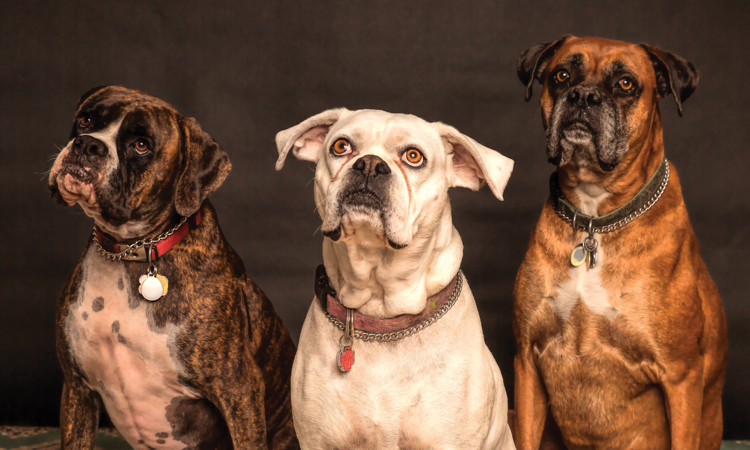
A 2014 study in California suggests dogs can in fact display jealous behaviours. The experiment studied 36 dogs individually while using a stuffed dog. When the owners showed affection towards the toy, the dogs showed significant jealousy through snapping, getting between the owner and toy, or pushing and touching the owner or toy.
The results revealed that 41% of dogs snapped at the toy, every dog pushed at the owner, and 86% pushed at the fake dog. The study suggests that because most dogs sniffed the fake dog’s private areas, they thought the toy was real. This could be why most dogs appeared to be jealous as they thought the toy was a rival they needed to compete with.
Why does my dog get jealous?
Our dogs thrive when they’re in a stable environment and get all the things they need in life – like attention and food. When something bulldozes in and changes home life, our dogs can find it difficult to adjust. If your dog feels they need to compete for the things they love, that’s when those unwanted behaviours can come out.
There could be many reasons why your dog gets jealous. Maybe you recently brought a new puppy or pet into your home. Perhaps you have a new baby in the house or a new partner has moved in. Dogs feel secure when they have a routine, but new family members can upset the status quo they’ve come to rely on.
Jealousy could also become an issue if you’ve moved to a new home or neighbourhood, or if you’ve introduced a new schedule. In an unfamiliar home environment, your dog may be figuring out where they belong and try to compete for new places or items in the home. If you have a new work schedule, your dog could be trying to compete for your time and affection.
How can I tell if my dog is jealous?
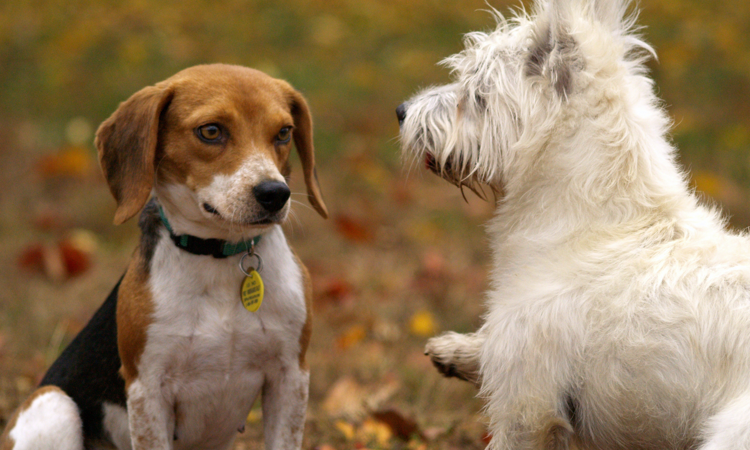
Dogs communicate jealousy through many different behaviours. Watch out for these signs if you suspect your dog is jealous.
1. Aggression
A jealous dog may growl, snap or attack another person or pet if they go near the thing they want. This could happen when you’re sitting on the sofa and a family member comes to sit next to you, or if another dog comes near their favourite toy. Aggressive behaviour is giving the other party a clear warning to back off.
2. Pushy behaviour
If you’re giving someone else attention, does your dog ever push them out of the way or squeeze between you? Or if you’re having coffee with a friend, maybe they jump onto your lap. If your dog is jealous they may push themselves into the situation and demand you give them attention.
3. Peeing indoors
Not all jealous behaviour is as obvious as our own. Because our dogs can’t tell us how they’re feeling, they use other ways to communicate. If your dog doesn’t know any other way to express themselves, peeing or pooping in the house could be a sign your dog is jealous.
4. Performing a trick
Dogs are clever animals – through your training sessions they quickly learn that doing tricks gets them attention and treats. So if you’re busy entertaining guests and they’re desperate for your attention, they may randomly pull tricks in an attempt to get what they want.
5. Walking away
If your dog is upset that someone else is taking the limelight, their jealousy may not always be shown by putting up a fight. Withdrawing and leaving the room could be your dog’s way of expressing their unhappiness with the situation.
6. Excessive grooming
Indirect behaviours such as over grooming can be a sign of jealousy. If your dog is bothered by a new family member, grooming can be your dog’s way of dealing with their insecurities. In a way, it’s an effective form of self-soothing when handling new stresses at home.
7. Under or overeating
A change in your dog’s eating habits can also be an indirect form of jealousy. If your dog has become anxious and stressed about competing for your affection with other people and pets, this can have an affect on their appetite.
How to handle dog jealousy
Avoid positive reinforcement of “bad” behaviour
Unfortunately, it’s all too easy for us to unintentionally reinforce our dogs’ attention-seeking ways. When your dog wants something and doesn’t get it, they may start to “act out” or behave in a way to get what they’re after. This could be to get your affection, a tasty treat or a favourite toy.
The problem is, we’re often tempted to give into their adorable, sometimes downright annoying, or even distressing, calls for attention – this only teaches the dog that the behaviour will lead to a reward, whether that’s physical affection, a treat or a toy. This is known as positive reinforcement – and it’s possible to reinforce negative behaviours, too. If your dog ends up getting what they want, they’ll learn to repeat what they were doing just before getting the reward.
Dog attention seeking can range from the mild such as staring or licking you, to the annoying such as barking or whining, to more extreme signs such as aggressive behaviour.
Understanding what your dog is trying to tell you
Because dogs can’t communicate using words, it can be difficult for us to know exactly what they’re telling us. It’s important to get to know your own dog and to understand what’s your dog’s noises and other communications mean so you know what their individual needs and patterns are. At the same time it’s crucial to establish yourself as the leader of the pack in your home – and to know how to bring out and reward the kind of behaviours you want to see your dog adhere to.
If your attention is important to pup, they may see other people and animals as a threat to their relationship with you and play up to warn off the competition. Dogs can show their jealousy in all sorts of situations, but these are some of the most common:
- Your dog growls at another pet or family member approaching you.
- If you’re paying attention to another another dog and your dog pushes them out of the way.
You’re with a friend and your dog whines at your feet or tries to push between you.
So now you know why your pooch might be jealous and what it looks like, here are a few methods you can use to minimise your dog’s jealousy.
Dog jealousy of a new puppy or other pet
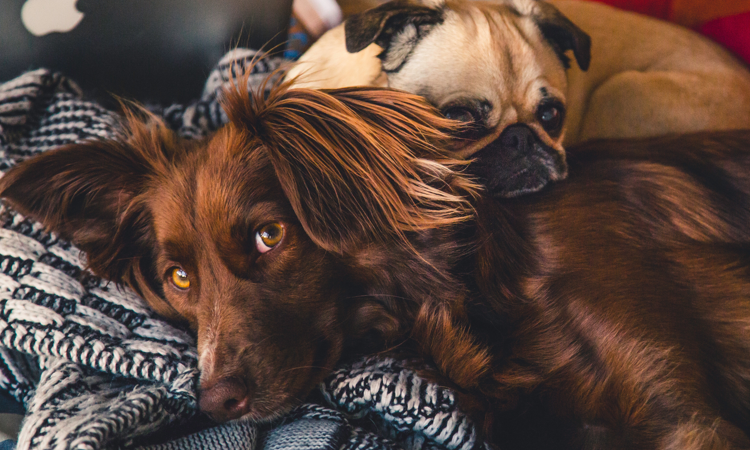
If you’ve noticed your dog’s behaviour has changed since bringing a new pet home, this could very well be the cause of their jealous behaviour. The key is to make them both feel equally important to you and strengthen the bond between them both. Here are a few tactics you can try:
- Always give both dogs equal attention and pet and play with them together. This will ensure neither dog feels left out and will also help them build their relationship with each other.
- If your dog is protective over their food, feed them in different rooms to avoid any feelings of competition.
- Take both dogs on walks together – there’s no better bonding session than being outdoors and learning to play and socialise with other dogs together.
- Do your training sessions with both dogs together. This will help pup feel they’re getting their fair share of time with you. Be sure to give both dogs treats at the same time to avoid any conflicts over food.
- If you’ve noticed arguments over toys or beds, be sure to have two of everything so there’s less chance of rivalry.
- Always reward the small wins. When they’re acting appropriately like sitting calmly together or sitting next to you without issue, give them both attention and a reward.
Dog jealousy of people
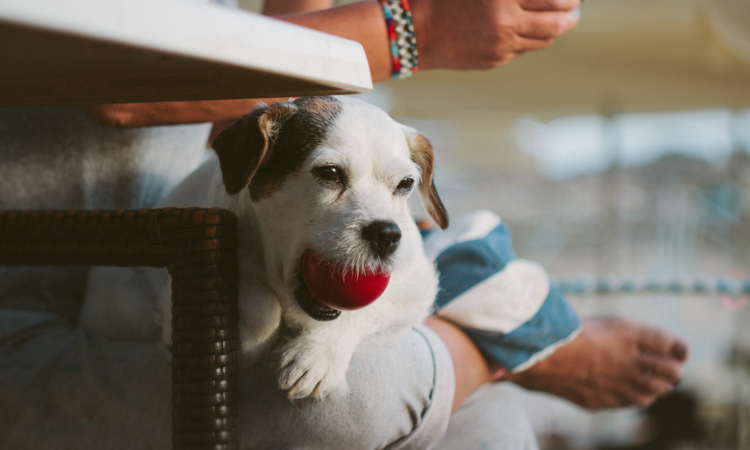
If you suspect your dog is jealous of family members, the problem could be there’s no relationship between them. Your dog sees you as the most important thing in their life and they may not have connected with others. In this case, you need to show your dog what’s unacceptable and create a better bond between your dog and the rest of family. Here are a few things to try:
- Praise and reward the good behaviour – if they manage to remain calm when you’re in the company of other people or family members, for example.
- This helps your dog form a positive association with others. Have your partner tag along for walks or involve them in playtime and training. Let the family member prepare your dog’s meals so they come to view them as another provider of positive things.
- If your dog growls or snaps at people when they approach, you need to give a clear signal that that is unacceptable. Your dog should always understand that they rank lower than humans. You do this by removing access to the reward, which in most cases is you. When they show attention grabbing or pushy behaviour, you should ignore them.
- Consistency is key – you’ll have to repeat this every time and get your whole family on board, too. It won’t work if your dog learns that they can get attention and fuss elsewhere in the household!
Your dog needs to be shown that good and fun things happen whenever the other person is around.
Dog jealousy of a baby
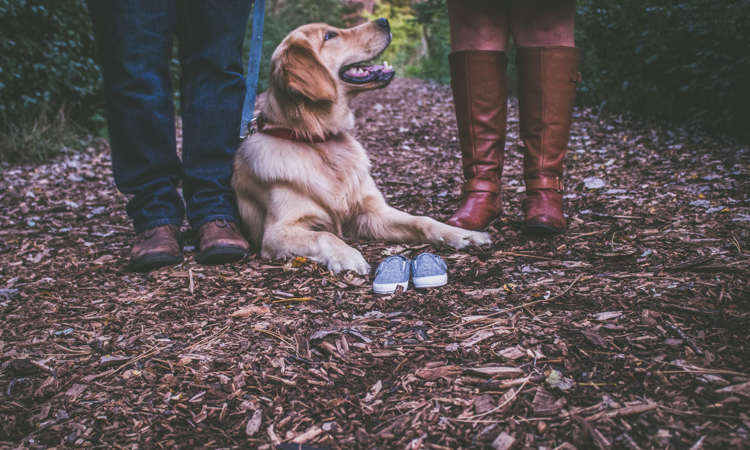
A new baby can be a magical time for your family but can also be an overwhelming and confusing experience for your dog. As with any human and dog relationship, your dog needs to understand they don’t rank higher than your baby, nor is the baby your dog’s playmate. Here are a few ways to prevent your dog being jealous of your new baby.
- Make the nursery off limits weeks before the birth. That way when your baby does arrive your dog won’t connect being excluded with the new arrival.
- Don’t keep your dog away from your baby. This can give your dog a reason to think they’re in competition or should feel threatened by them. Involve your dog in family life and avoid feeling tense when they’re together. If you feel tense your dog may sense it and could think there’s reason to be anxious.
- Help your dog bond with your baby by rewarding and praising good behaviour. Offer rewards when they’re laying beside them or calmly playing in the same room. Your dog will eventually understand that good things happen when they’re calm and relaxed around your baby.
- Never leave your dog and baby alone together. You never know how your dog might react unsupervised and it could reverse any good work you’ve put into training.
- Your dog shouldn’t be allowed to play with your baby’s toys. There are thousands of bacteria in your dog’s mouth which could be harmful to your baby. If they grab your baby’s toys to try and get your attention, take the toy away and redirect them onto their own. Offer praise and a reward when they’re happily occupied. And just to state the obvious, always wash your baby’s toys before playing with them again.
Do you have a jealous pooch? Share your dog jealousy stories in the comments below or head over to Facebook and Twitter at @DogBuddyCo.